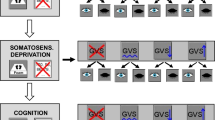Abstract
The postural stability of 30 panic disorder (PD) patients and 30 sex- and age-matched healthy control subjects (age range 27–40 years) was investigated by static posturographic tests of quiet standing on stable and foam surfaces with open and closed eyes. Postural stability was evaluated by sway velocity (SV) and power density of relative power spectrum (RPS) in five frequency ranges. There were no differences of SV between two groups during stance with open eyes on both surfaces. The SV of the PD patients standing with closed eyes was significantly higher compared to controls for the stance on the stable surface (anterior–posterior plane) and on the foam surface (both anterior–posterior and medial–lateral planes). The stance on foam surface did not cause any significant changes in power density of postural sways of healthy subjects, while this parameter was significantly higher for PD patients, especially in closed eyes condition when a sensory conflict may exist. The higher value of SV and RPS (0.5–1.0 Hz) in patients compared to controls suggests that the visual information has more important role in the postural balance when sensory conflict exists during stance on foam surface. We proposed that the altered information from the visual and proprioceptive inputs may induce anxiety and panic symptoms in PD patients, which enhances the sensory conflict, leads to abnormal work of the vestibular system and disturbs the standing balance.


Similar content being viewed by others
References
American Psychiatric Association (1994) Diagnostic and statistical manual of mental disorder, 4th edn. APA, Washington
Balaban CD, Thayer JF (2001) Neurological bases for balance-anxiety links. J Anxiety Disord 15(1–2):53–79
Dichgans J, Mauritz KH, Allum JHJ, Brandt T (1976) Postural sway in normals and atactic patients: analysis of stabilizing and destabilizing effects of vision. Agressologie 17:15–24
Dichgans J, Brandt T (1978) Visual–vestibular interaction: effects on self-motion perception and posture control. In: Held R, Leibowitz HW, Teuber HL (eds) Handbook of sensory physiology. Springer, Berlin, pp 755–804
Furman JM, Jacob RG (2001) A clinical taxonomy of dizziness and anxiety in the otoneurological setting. J Anxiety Disord 15:9–26
Fitzpatrick R, McCloskey DI (1994) Proprioceptive, visual and vestibular thresholds for the perception of sway during standing in humans. J Physiol (Lond) 478:173–186
Granat MH, Kirkwood C, Andrews B (1990) Problem with the use of total distance travelled and average speed as measures of postural sway. J Med Biol Eng Comp 28:601–602
Jacob RG (1988) Panic disorder and the vestibular system. Psychiatry Clin N Am 11:61–71
Jacob RG, Furman JM, Clark DB, Durrant JD (1992) Vestibular symptoms panic and phobia: overlap and possible relationship. Ann Clin Psychiatry 4:163–174
Jacob RG, Furman JM, Durrant JD, Turner SM (1996) Panic, agoraphobia and vestibular dysfunction. Am J Psychiatry 53:503–512
Nashner LM, Black FO, Wall C (1982) Adaptation to altered support and visual conditions during stance: patients with vestibular deficits. J Neurosci 2:536–544
Perna G, Dario A, Caldirola D, Barozzi S, Cesarani A, Bellodi L (2001) Panic disorder: the role of the balance system. J Psychiatr Res 35:279–286
Prieto TE, Hoffman RG, Lovett EG, Myklebust BM (1996) Measures of postural steadiness: differences between healthy young and elderly adults. IEEE 43(9):956–966
Perry S, McIllroy W, Maki B (2000) The role of plantar cutaneous mechanoreceptors in the control of compensatory stepping reactions evoked by unpredictable, multi-directional perturbation. Brain Res 877(2):401–406
Peterka RJ, Benolken MS (1995) Role of somatosensory and vestibular cues in attenuating visually induced human postural sway. Exp Brain Res 105:101–110
Ratcheva T, Stambolieva K, Kostadinov K (1999) Posturograph with position-sensitive detector and method for it’s preparing. BG Patent #61749. http://v3.espacenet.com/publicationDetails/originalDocument?CC=BG&NR=61749B1&KC=B1&FT=D&date=19980529&DB=EPODOC&locale=en_EP
Rama-Lorez J, Pereze N, Martinez Vila E (2004) Dynamic posture assessment in patients with peripheral vestibulopathy. Acta Otolaryngol 124(6):700–705
Stambolieva K, Racheva T, Kostadinov K (1998) Posturographic system with position-sensitive detector of registration. In: Proceedings of the seventh international conference “Electronics ’988”, vol 3, pp 45–50
Shumway-Cook A, Horak F (1986) Assessing the influence of sensory interaction on balance. Phys Ther 66:1548–1559
Wu G, Chiang JH (1997) The significance of somatosensory stimulations to the human foot in the control of postural reflexes. Exp Brain Res 114(1):163–169
Yardley L, Owen N, Nazareth I, Irwin PD, Luxon L (2001) Panic disorder with agoraphobia associated with dizziness: characteristic symptoms and psychosocial sequelae. J Nerv Ment Dis 189:321–327
Acknowledgments
The study was supported by the National Fund for Scientific Research, Grants #TN 1522.
The authors declare that they have no conflict of interest, including any financial, personal or other relationships with other people or organizations.
Author information
Authors and Affiliations
Corresponding author
Rights and permissions
About this article
Cite this article
Stambolieva, K., Angov, G. Balance control in quiet upright standing in patients with panic disorder. Eur Arch Otorhinolaryngol 267, 1695–1699 (2010). https://doi.org/10.1007/s00405-010-1303-2
Received:
Accepted:
Published:
Issue Date:
DOI: https://doi.org/10.1007/s00405-010-1303-2




